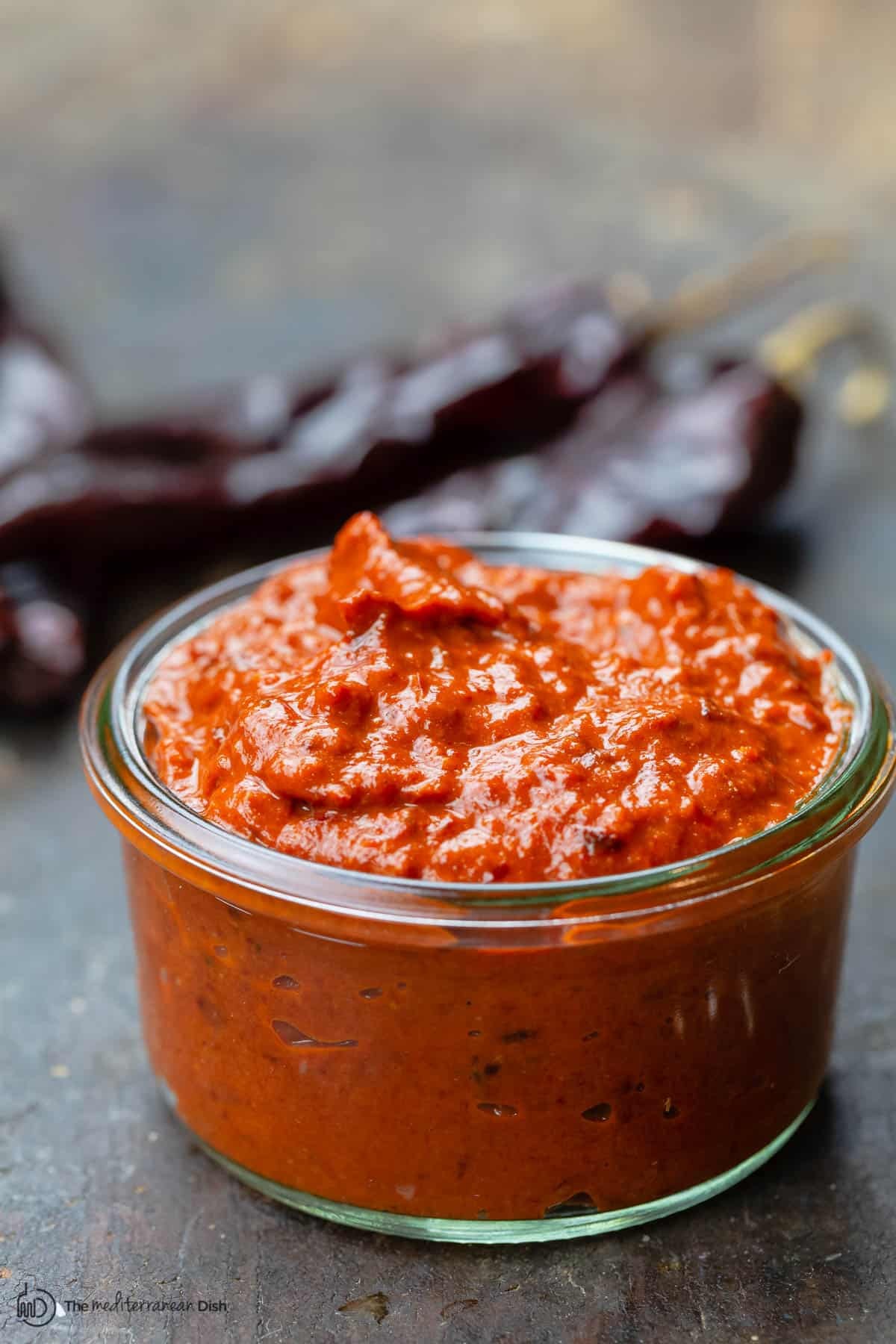Harissa is more than just a condiment; it’s a culinary cornerstone of North African cuisine. This vibrant red chili paste, originating from Tunisia, is a versatile ingredient made from simple yet impactful components: chili peppers, garlic, olive oil, citrus, and a blend of warm spices. Often compared to ketchup or sriracha for its ubiquity in the region, harissa boasts a far more complex and addictive flavor profile that elevates countless dishes.
Delving into Harissa: More Than Just a Hot Sauce
While you might find harissa readily available in stores, often in jars or tins, understanding what truly sets it apart begins with appreciating its homemade essence. This is where the magic unfolds, transforming simple ingredients into a symphony of flavors. Harissa is traditionally made from dried red chilies, garlic, a touch of citrus, high-quality extra virgin olive oil, and a selection of aromatic spices. Common spices include cumin, coriander, and caraway seeds, each contributing a layer of depth to the paste.
But what does harissa actually taste like? Imagine a condiment that is mildly spicy, offering just the right amount of heat, balanced with sweetness, a hint of smokiness, and a tangy zest. This homemade harissa recipe achieves precisely that – a truly addictive flavor that will keep you coming back for more. The beauty of homemade harissa lies in its customizable nature and the fresh, vibrant flavors that store-bought versions often lack. Making it at home is surprisingly easy, as you’ll discover.
Key Ingredients for Authentic Harissa
The nuanced flavor of harissa hinges on the quality and combination of its ingredients. Experimenting with different types of chilies and spice ratios allows for a personalized heat and flavor profile. Here’s a breakdown of the essential components:
- Dried Red Chilies: The heart of harissa. The type of chili used significantly impacts the heat level and overall flavor. New Mexico or Guajillo chilies are excellent choices for a milder harissa with a nuanced flavor. For those who prefer more heat, adding hotter varieties like de arbol peppers is an option. Chipotle peppers can introduce a smoky dimension. Using a blend of chilies can create a more complex and balanced harissa.
- Roasted Red Peppers: These contribute sweetness and body to the harissa paste. Jarred roasted red peppers are a convenient option, just be sure to drain them well before use.
- Tomato Paste: A touch of tomato paste adds umami depth, enhancing the savory notes of the harissa.
- Fresh Garlic Cloves: Garlic is a crucial aromatic element. Adjust the quantity to your preference, but a generous amount is generally favored.
- Spices: A carefully selected blend of spices defines the character of harissa. Coriander and cumin are essential for their warm, earthy notes. Caraway seeds, toasted and ground, add a distinctive anise-like aroma. Smoked paprika introduces smokiness without adding extra heat, and a pinch of cayenne pepper can further customize the spice level.
- Lemon Juice: Citrus is vital for brightness and balance. Fresh lemon juice cuts through the richness and rounds out the flavors.
- Extra Virgin Olive Oil: A generous drizzle of good quality extra virgin olive oil is incorporated while blending, creating the desired paste-like texture and adding richness and fruity notes.
Step-by-Step Guide: Making Harissa at Home
Creating homemade harissa is a simple process that yields a significantly more flavorful result than store-bought alternatives.
- Soak the Dried Chilies: Begin by rehydrating the dried red chilies. Place them in a heatproof bowl and cover with hot water. Allow them to soak for about 30 minutes until they become softened and plump.
- Prepare the Chilies and Combine Ingredients: Once softened, drain the chilies and remove the stems and seeds to control the heat level. Transfer the prepared chilies to a food processor. Add the roasted red peppers, tomato paste, garlic cloves, toasted and ground caraway seeds, coriander, cumin, smoked paprika, cayenne pepper (if using), and a pinch of kosher salt. Squeeze in the fresh lemon juice.
- Blend into Harissa Paste: Process all the ingredients in the food processor until they are well combined. While the processor is running, slowly drizzle in the extra virgin olive oil through the top opening. Continue to process until you achieve a smooth, slightly chunky paste. Stop to scrape down the sides of the bowl as needed to ensure even blending.
- Taste and Adjust: Taste the harissa paste and adjust the seasonings according to your preference. You can add more salt, lemon juice, or spices to achieve your desired flavor profile. Keep in mind that the flavors will meld and deepen as the harissa sits.
Storing Your Homemade Harissa
Proper storage ensures your homemade harissa retains its vibrant flavor and quality.
- Refrigerator Storage: Transfer the harissa paste to a clean mason jar or airtight container. To help preserve it and create a seal, drizzle a thin layer of extra virgin olive oil over the top of the paste before sealing the jar tightly with a lid. Stored in the refrigerator, homemade harissa will typically last for 2 to 3 weeks.
- Freezing: For longer storage, harissa paste can be frozen for up to a month. It’s best to freeze it in smaller, individual portions for convenient use later on.
Unleashing the Flavor: Ways to Use Harissa
Once you have a jar of homemade harissa, you’ll discover its incredible versatility in the kitchen. It adds a flavorful kick to a wide array of dishes:
- Marinades and Rubs: Use harissa as a marinade for meats like chicken, lamb, or beef, or as a flavorful rub for fish and seafood before grilling or roasting.
- Spice up Vegetables: Toss roasted vegetables like potatoes, carrots, or cauliflower with harissa for an extra layer of flavor.
- Soups and Stews: Stir a spoonful of harissa into soups, stews, and tagines to add warmth and depth.
- Dips and Spreads: Incorporate harissa into dips like hummus or baba ghanoush, or spread it on sandwiches and wraps for a spicy condiment.
- Egg Dishes: Add a dollop of harissa to shakshuka or scrambled eggs for a flavorful breakfast or brunch.
- Grain Bowls: Enhance grain bowls with a touch of harissa for a spicy and complex flavor component.
Embrace the versatility of harissa and experiment with it in your favorite recipes. You’ll soon find yourself reaching for this flavorful North African paste to add a touch of excitement to your everyday cooking.
Easy Homemade Harissa Recipe
Print Recipe Pin Recipe Rate this Recipe
By Suzy Karadsheh
Make this easy harissa paste with dried chilies, garlic, and warm North African spices. Keep it in your fridge to elevate meat, chicken, fish, or vegetables. Stir it into soups and stews, or add a kick to your shakshuka or hummus!
Prep Time 10 minutes
Cook Time 0 minutes
Soak Time 30 minutes
Total Time 10 minutes
Cuisine: Mediterranean, North African
Servings: 24 tablespoons
Course: Condiment, Sauce
Equipment
- Food Processor
Ingredients
- 7 Dried New Mexico Chilies or Guajillo Chilies, or a combination of dried New Mexico Chilies and another kind of dried hot chilies such as de arbol or chipotle chilies
- 6 oz jarred roasted red peppers, drained rinsed, and dried (2 large peppers)
- 2 tbsp tomato paste
- 4 large garlic cloves, peeled
- 1 tsp caraway seeds, toasted and ground (use a mortar and pestle, grinder or food processor)
- 2 tsp ground coriander
- 2 tsp ground cumin
- 1 tsp smoked paprika
- ½ tsp cayenne pepper
- Kosher salt
- Juice of 1 large lemon, 2 tbsp fresh lemon juice
- 2 tbsp quality extra virgin olive oil, more for later
Instructions
- Soak and prepare the dried chilies: Place the dried chilies in a heat-safe bowl and cover with hot water. Set aside for 30 minutes until the chilies are tender and re-hydrated. Drain the chiles and remove the stems and seeds.
- Combine chilies with the remaining ingredients: Transfer the chilies to the bowl of a large food processor fitted with a blade. Add the tomato paste, roasted red peppers, garlic, ground caraway seeds, coriander, cumin, smoked paprika, cayenne (if using), and a large pinch of kosher salt. Add fresh lemon juice.
- Make the harissa paste: Run the food processor, and while it’s running, drizzle the extra virgin olive oil from the top opening. Stop the processor to scrape down the sides and run again until you reach the desired paste-like texture. Taste and adjust seasonings to your liking (remember that harissa paste will deepen in flavor as it sits in the fridge over the next day or two).
- Store: Transfer the harissa paste to a clean mason jar. Cover with a very thin layer of extra virgin olive oil, then cover the jar with its lid tightly and refrigerate.
Video
[Link to Video – if available, insert here]
Notes
- Yield: This recipe makes about 1 1/2 cups of harissa paste. Serving size is 2 tablespoons.
- Cook’s Tip: You can use this homemade harissa paste immediately, but for the best flavor, allow it to sit in the fridge for at least 1 to 2 days.
- Storage: Homemade harissa can last in the fridge for 2 to 3 weeks when properly stored in a covered mason jar with a thin layer of extra virgin olive oil covering the top of the paste. Replenish the olive oil layer after each use before refrigerating again.
- Freezing: Yes, harissa paste can be frozen for up to 1 month. It is recommended to freeze individual smaller portions.
- Visit Our Shop: Visit Our Shop to browse quality Mediterranean ingredients, including spices and extra virgin olive oil used in this recipe.
Nutrition
Serving: 2tbsp | Calories: 13.4kcal | Carbohydrates: 0.6g | Protein: 0.1g | Fat: 1.3g | Saturated Fat: 0.2g | Sodium: 11mg | Potassium: 20.3mg | Fiber: 0.2g | Sugar: 0.2g | Vitamin A: 79.1IU | Vitamin C: 0.3mg | Calcium: 3.7mg | Iron: 0.2mg
Tried this recipe? Mention @Themediterraneandish Or Tag #Themediterraneandish!

